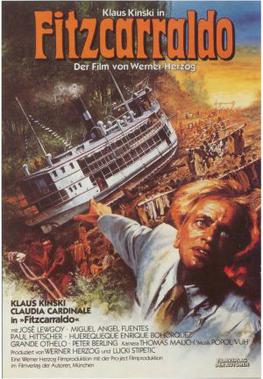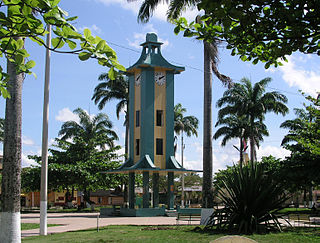
Fitzcarraldo is a 1982 West German epic adventure-drama film written, produced, and directed by Werner Herzog, and starring Klaus Kinski as would-be rubber baron Brian Sweeney Fitzgerald, an Irishman known in Peru as Fitzcarraldo, who is determined to transport a steamship over a steep hill to access a rich rubber territory in the Amazon basin. The character was inspired by Peruvian rubber baron Carlos Fitzcarrald, who once transported a disassembled steamboat over the Isthmus of Fitzcarrald.

Puerto Maldonado is a city in southeastern Peru in the Amazon rainforest 55 kilometres (34 mi) west of the Bolivian border, located at the confluence of the Tambopata and Madre de Dios rivers. The latter river joins the Madeira River as a tributary of the Amazon. This city is the capital of the Department of Madre de Dios.
Vaca Diéz is a province in the Beni Department, Bolivia. The two largest settlements in Vaca Diéz are Guayaramerín with a population of 35,764 in 2012, along with Riberalta with a population of 78,754. Vaca Diéz measures 16,228 km² in size.

Riberalta is a town in the Beni Department in northern Bolivia, situated where the Madre de Dios River joins the Beni River. Riberalta is on the south bank of the Beni River.

The Carlos Fermín Fitzcarrald Province is one of 20 provinces of the Ancash Region of Peru. It is named after Carlos Fermín Fitzcarrald, the rubber tycoon whose life served as an inspiration behind the 1982 film Fitzcarraldo.
Cachuela Esperanza is a village in the Bolivian Departamento Beni.

La Casa de Fierro, located in the city of Iquitos in the jungle of Peru, in front of the major square between Próspero and Putumayo streets, is a large iron residence built during the rubber boom at the end of the nineteenth century. The house was bought by the Bolivian explorer and entrepreneur Antonio Vaca Diez.

Guayaramerín is a city within the Bolivian Beni Department. It is the capital of the Guayaramerín Municipality in the Vaca Díez Province. Guayaramerín is located on the west side of the Mamoré River, facing the Brazilian city of Guajará-Mirim. It is a port in which there is a permanent port of the Bolivian Navy. Guayaramerín Airport is south of the city, and served by Ecojet.

Nicolás Suárez Callaú set up a multinational rubber empire in South America at the beginning of the 20th century.

The Amazon rubber cycle or boom was an important part of the economic and social history of Brazil and Amazonian regions of neighboring countries, being related to the extraction and commercialization of rubber. Centered in the Amazon Basin, the boom resulted in a large expansion of colonization in the area, attracting immigrant workers, generating wealth, causing cultural and social transformations, and disrupting local indigenous societies.

This is a timeline of Amazon history, which dates back at least 11,000 years ago, when humans left indications of their presence in Caverna da Pedra Pintada.

The Tambopata River is a river in southeastern Peru and northwestern Bolivia. Most of the Tambopata is in the Madre de Dios and Puno regions in Peru, but the upper parts of the river forms the border between Peru and Bolivia, and its origin is in La Paz department in Bolivia. The Tambopata is a tributary of the Madre de Dios River, into which it merges at the city of Puerto Maldonado. The river flows through the Tambopata National Reserve.

Carlos Fermín Fitzcarrald López was a Peruvian rubber baron. He was born in San Luis, Ancash, in a province that was later named after him. In the early 1890s, Fitzcarrald discovered the Isthmus of Fitzcarrald, which was a portage route from the Ucayali River into the Madre de Dios River basin. Fitzcarrald became known as the "King of Caucho" due to his success during the rubber boom. His enterprise exploited and enslaved Asháninka, Mashco-Piro, Harákmbut, Shipibo-Conibo and other native groups, who were then dedicated to the extraction of rubber. In 1897, Fitzcarrald, along with his Bolivian business partner Antonio Vaca Díez, drowned in an accident on the Urubamba River.

The Tahuamanu River is a river of Bolivia and Peru. Nícolas Suárez Callau enslaved and exploited natives along the Tahuamanu during the rubber boom.
Porvenir is a small town in the Nicolás Suárez Province of the Pando Department in Bolivia. It is located 33 kilometers south of Cobija, the department's capital city, at an altitude of 222 m on the left banks of Tahuamanu River, which in its later course is named Orthon River before it discharges into Beni River.

Puerto Rico is a small town in Pando, northern Bolivia, with an associated airport. It is located in the Manuripi-Heath Amazonian Wildlife National Reserve. Founded on May 18, 1890, it was the first departamental capital, before Cobija. It is located at the Confluence of the Manuripi and Tahuamanu Rivers. Every year, in the month of June, the International Recreational Fishing Championship of Puerto Rico takes place at the river confluence, where the two rivers combine to form the river the River Orthon. This river then flows 410 km before it converges with the River Beni.

The Acre War, known in Brazil as Acrean Revolution and in Spanish as Guerra del Acre was a border conflict between Bolivia and the First Brazilian Republic over the Acre Region, which was rich in rubber and gold deposits. The conflict had two phases between 1899 and 1903 and ended with an Acrean victory and the subsequent Treaty of Petrópolis, which ceded Acre to Brazil. The outcome also affected territories disputed with Peru.

José Plácido de Castro was a Brazilian soldier, surveyor, rubber producer and politician who led the armed revolt during the Acre War of 1902–3, when the Republic of Acre broke away from Bolivia. He was the president of the state of Acre just before and after it was purchased by Brazil. After the war he became extremely wealthy as a rubber producer, and made many enemies. He was assassinated in 1908. He is considered a hero of Brazil.

The Fitzcarrald Isthmus is an 11 km long land bridge that connected important rubber trade routes of the Urubamba River and the Madre de Dios River in Peru.

Carlos Scharff was a Peruvian rubber baron of German descent who was active along the Upper Purus and Las Piedras rivers during the Amazon rubber boom in Peru. He also served for many years during his youth as an agent for the Belgian consulate in Brazil.


















